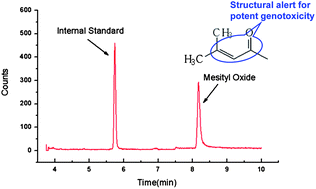Trace-level analysis of mesityl oxide in enalapril maleate by gas chromatography with electron ionization mass spectrometry
Abstract
The determination of genotoxic impurities in

* Corresponding authors
a
Department of Chemistry, Shanghai Institute for Food and Drug Control, Shanghai 201203, China
E-mail:
ming0519@hotmail.com
Fax: +86 21 50798189
Tel: +86 21 38839900 ext. 26313
The determination of genotoxic impurities in

 Please wait while we load your content...
Something went wrong. Try again?
Please wait while we load your content...
Something went wrong. Try again?
M. Peng, H. Wen, J. Le and Y. Yang, Anal. Methods, 2012, 4, 4063 DOI: 10.1039/C2AY25884F
To request permission to reproduce material from this article, please go to the Copyright Clearance Center request page.
If you are an author contributing to an RSC publication, you do not need to request permission provided correct acknowledgement is given.
If you are the author of this article, you do not need to request permission to reproduce figures and diagrams provided correct acknowledgement is given. If you want to reproduce the whole article in a third-party publication (excluding your thesis/dissertation for which permission is not required) please go to the Copyright Clearance Center request page.
Read more about how to correctly acknowledge RSC content.
 Fetching data from CrossRef.
Fetching data from CrossRef.
This may take some time to load.
Loading related content
